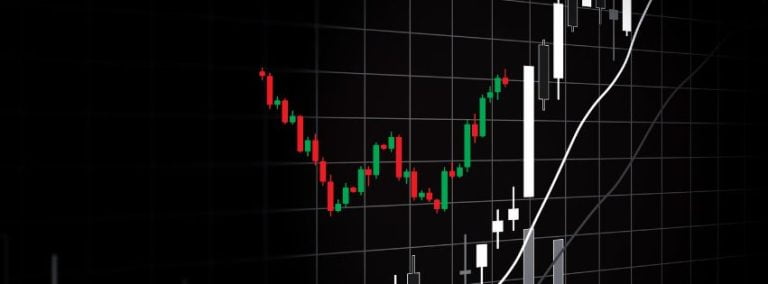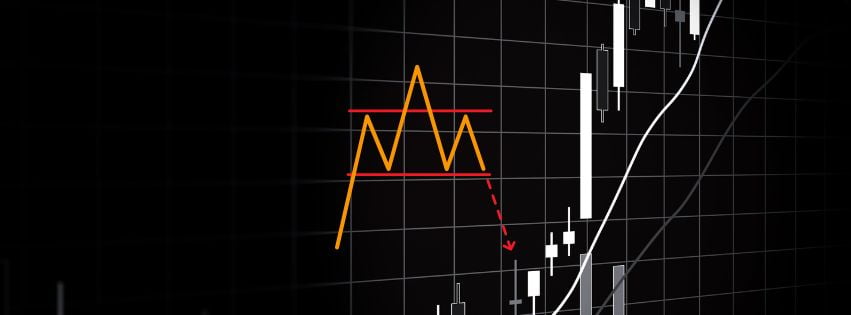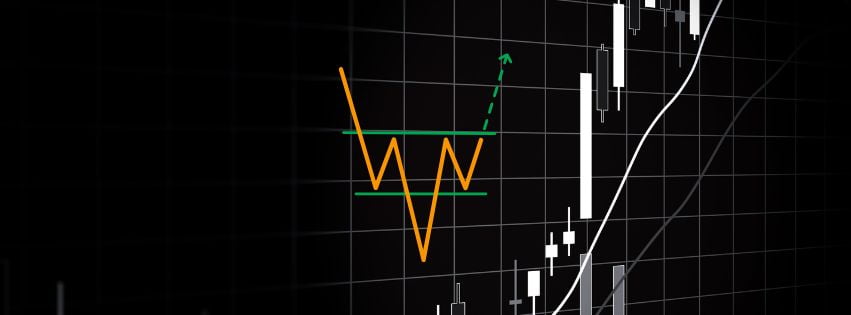The double bottom pattern is a bullish reversal indicator, signaling a potential end to a downtrend. It appears more frequently than another bullish reversal pattern, the Inverted Head and Shoulder, thereby offering more trading opportunities. In this article, we will explore how to identify and trade this candlestick pattern with a Forex trading example.
Double Bottom Pattern Meaning
The double bottom formation pattern is a signal of potential reversal of a downtrend, characterized by two price bottoms closely aligned with each other. Its appearance on a chart resembles the letter ‘W’, earning it the nickname ‘W bottom’.
The double bottom pattern consists of three formations: the left bottom, the neckline, and the right bottom.
The left bottom is formed by a rebound after a prolonged downtrend. Initially, the rebound is short-lived, as buying pressure remains subdued. However, the subsequent decline finds support above the low price of the left bottom, leading to a second rebound.
The second rebound gains strength and surpasses the high price of the first rebound, signaling the beginning of a new uptrend.
Double Bottom Breakout & Entry
1). Double Bottom Breakout
When the market price breaks above the neckline, the double bottom pattern breakout occurs, confirming the formation of the pattern. Therefore, the neckline plays a crucial role in trading the double bottom.
The neckline of the double bottom is a horizontal line drawn from the high price of the left bottom, acting as the resistance line. As illustrated on a 4-hour EURUSD Forex trading chart below, in many cases, the neckline aligns with the resistance level converted from the previous low price support line.
2). Double Bottom Pattern Entry
There are two entry points in trading the double bottom pattern. The first entry to place a long position, occurs when the neckline is broken. The second entry is during the neckline retest.
The W bottom on the previous EUR/USD chart includes a neckline retest, where the price fell back to the neckline shortly after the breakout. If the market finds support at this level, this provides a second double bottom patter entry point. The neckline retest reflects the common concept of resistance and support interchanging roles.
Double Bottom Pattern Target
Now that we understand the entry points for the double bottom, the next question is how to set the target after entry. The double bottom target, indicating the expected price rise after the neckline breakout, can be calculated using the following formula:
Double Bottom Patter Target = Neckline Price + (Neckline price – Low Price of the Pattern)
We will use a Forex trading example to explain the formula. Suppose there is a double bottom pattern on the USD/JPY daily chart, with the neckline at 155.000 and the low price at 150.000. The target of the pattern is calculated as follows: [155 + (155 – 150)] = 160.000.
In other words, once a W pattern is confirmed, the market is expected to rise at least by the same distance as the height of the pattern. In many cases, the price will increase beyond the target.
Double Bottom Pattern Stop Loss
Now that we have explained the entry and target, the final step in trading the W bottom is to set the stop loss. Unlike the target, the stop loss for a double bottom can vary depending on the trader’s risk tolerance and account size.
There are two common appoaches in setting the double bottom stop loss:
1). Below the right bottom
he simplest method is to place the stop loss below the right bottom. This approach is suitable for traders with high risk tolerance, considering the potential significant loss. In many cases, it’s unnecessary to wait until the price reaches this level to determine a failed pattern.
2). Below the key support before the breakout
If no other clear support level is present below the neckline, set the stop loss below the low of the candlestick before the neckline breakout. While this provides a relatively tight stop loss, there is a risk of being stopped out during a neckline retest.
Double Bottom Pattern Example
Having understood the entry point, target, and stop-loss calculation for the double bottom pattern, let’s proceed with an example to illustrate its application in trading. Below is a daily chart of the Nasdaq 100 index, depicting a clear double bottom pattern, along with key price information:
- Low price: 10,400
- Neckline price: 12,100
- Price distance of the pattern: 12,100 – 10,400 = 1,700
- Double bottom target price: 12,100 + 1,700 = 13,800
According to the explanation in this article, in this double bottom pattern, the first buying entry is at position 1 on the chart, followed by another two entries at positions 2 and 3. We will now detail each of these entries.
Entry point 1 – Double bottom breakout
The double bottom pattern breakout is the typical entry point. Traders often wait for confirmation with the second or third candlestick after the price breaks above the neckline before entering the trade. The entry price would be approximately 12,400, with a stop-loss set at 11,400.
Potential Profit:
13,800 – 12,400 = 1,400
Potential Loss:
12,400 – 11,400 = 1,000
Risk-to-Reward:
1,000:1,400 = 1:1.4
The potential risk-to-reward ratio for entering at this position is 1.4:1. While this isn’t a very high ratio, given that the W bottom pattern is clearly formed at this point, it remains a trade worth considering.
Entry point 2 – neckline retest
Entry point 2 occurs during a neckline retest at approximately 12,100, with a stop-loss set at 11,400. The potential risk-to-reward ratio here is 2.4:1, highlighting a lucrative trading opportunity. However, setting a tight stop-loss may result in being stopped out during the neckline retest.
Potential Profit:
13,800 – 12,100 = 1,700
Potential Loss:
12,100 – 11,400 = 700
Risk-to-Reward:
700 : 1700 = 1:2.4
Entry point 3 – right bottom forming
Some experienced traders with a high risk appetite may enter the market at point 3, buying around 11,000, with a stop-loss set just below the previous low at 10,200. Although not immediately recognizable, the early stages of a W bottom have emerged around point 3. Switching to a 4-hour or 1-hour chart reveals a smaller-scale W bottom formation in that area.
Potential Profit:
13800 – 11000 = 2800
Potential Loss:
11000 – 10200 = 800
Risk-to-Reward:
800 : 2800 = 1:3.5
The potential risk-to-reward ratio for buying at entry point 3 is 3.5:1, making it a risk worth taking. However, there’s a higher probability of being stopped out, as the formation of a double bottom pattern isn’t confirmed at this point.
Failed Double Bottom Pattern
The W bottom pattern often appears in the market, but this high frequency also means frequent failures. An example is seen on the hourly chart of the Hang Seng Index below, where all elements of a W bottom were present, but it failed during the neckline retest and broke below.
Not all double bottoms develop as expected in theory. Dealing with such failures lacks a foolproof method in the market to predict success or failure.
Strict stop-loss measures are essential when a W bottom fails, aiming to minimize potential losses. If the market trend diverges after entering a trade, the best action is to exit with a stop-loss order, reassess the market, and await new opportunities.
Other types of Double Bottom
Besides the standard pattern, there are other types of double bottom pattern, such as the triple bottom and multiple bottom. These patterns feature three or more bottoms with similar low prices. The trading rules remain consistent for these variants: enter the market after the neckline breakout and set the target based on the pattern’s height.
Triple Bottom
Multiple Bottom






